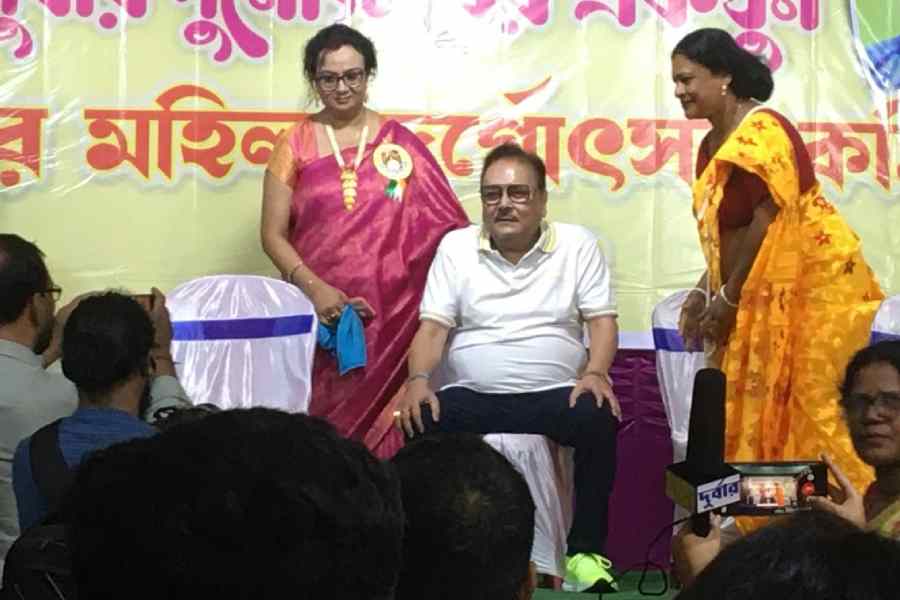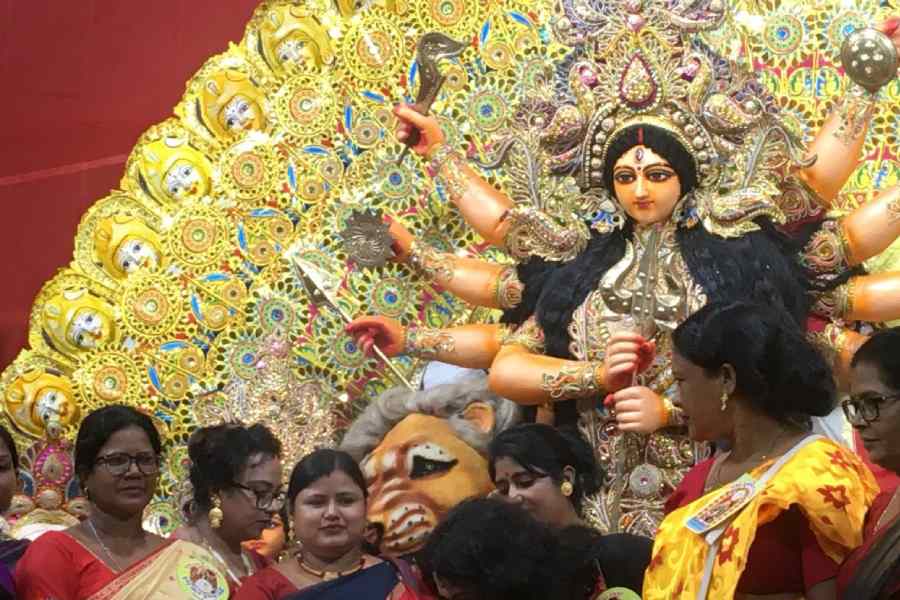A refusal to accept the traditional practice of earth being collected from a sex worker’s home for the making of the Durga idol led to this puja in Sonagachhi.
The earth is said to have the best qualities of mankind because the man drops them on the threshold of the home of the woman he is visiting in a brothel.
The puja in Sonagachhi, the largest red-light area of the city, is now 12 years old.
At its inauguration on Monday, its organisers, Durbar Mahila Samanwaya Committee, a collective of 40,000 sex workers across Bengal, remembered how the puja began 12 years ago with the refusal, followed by a long confrontation with the authorities and a legal battle that ended in victory.
No one wanted “prostitutes” to organise a puja.
"We fought and won. Ek jug,” said Bishakha Laskar, the secretary of the organisation, at the inauguration. A jug (yuga) is 12 years. "We need to remember our beginning.”
Durbar, meaning "unbeatable" and "unstoppable" in Bengali and began to function in the early 90s in Sonagachhi as an organisation of sex workers under the guardianship of Smarajit Jana, was built on the idea of choice.
The community wanted their work to be regarded as a profession.
Durbar played a crucial role in establishing in Sonagachhi the sex workers’ right to refuse customers if they did not want to use condoms.
“We did not want to be pitied. We did not want to be seen as people for whom anyone has to discard his best qualities,” says Soma Dutta (name changed), a senior member of the community.
“Besides, we would have a problem attending public pujas. We would be identified and humiliated,” she adds.

Trinamool leader Madan Mitra at the inauguration of the Durga Puja at Sonagachhi. Sourced by The Telegraph
In June 2013, at a Durbar meeting, Jana, then chief adviser of the organisation, asked the members if Durbar was ready to organise its own puja. The answer was an overwhelming yes.
“We approached the local political leaders, who asked us to get in touch with the police,” says Dutta, who came to Sonagachhi in the early 90s and has been with Durbar almost from the beginning. But the Burtolla police station refused to give us the permission.
“We were told that a new puja could not be allowed in the locality,” says Dutta.
“But the truth was that the ‘respectable’ society around us did not want to see us in public,” says Sumita Mukherjee (name changed), another senior leader of the community.
“Customers who are there the previous night do not recognise us the next morning,” she adds.
Durbar moved Calcutta High Court.
Lawyers Anindya Lahiri and Arunava Ghosh submitted a writ petition at the court of judge Sanjib Bandyopadhyay, who wanted a report from the police. He allowed the puja and criticised the discriminatory behaviour of the police.
The state government appealed against the single-bench verdict to a division bench of Justice Arun Mitra and Justice Joymalya Bagchi. The case was transferred to the high court division bench of Justice Ashim Kumar Banerjee and Justice Mrinal Kanti Chaudhuri.
They allowed the puja.
The September 26, 2013, verdict said: “Article 21 of the Constitution of India has guaranteed every citizen to have a decent living. Article 25 of the Constitution would, inter alia, grant freedom to the citizen of our country to perform religious rites.”
The Sonagachhi community was euphoric.
The moment the members heard the news on the phone, a meeting started in the Durbar office. Kumartuli artist Amar Pal, who knew about the puja, was given the order to make the idol.
Though held indoors, the first puja was memorable.
“The idol was imagined in a certain way,” says Dutta. Elokeshi Durga (Durga with her hair open and wild)would be killing an asura from whose breastplate would hang the contested sections of the Immoral Traffic Prevention Act, as suggested by the then Durbar secretary Bharati Dey: sections 3 (1), 4, 7, 8, 18 and 20, which implicate sex-workers.
Durbar has been against the criminalisation of sex workers.
“We are not criminals. We entertain men and take money for our work. This is not a crime,” says Dutta. “The puja was another battle won. Like our battles for a bank account, voter card, ration card, Aadhaar card.”
The first puja was inaugurated by an octogenarian member of the community, Manju. She had broken down holding the pradip in her hands. She had been brought to Sonagachhi when she was 12 or 13 by an uncle from her impoverished family in Burdwan and had never seen her family since.
One would earn 4 annas from a customer when she had first come to Sonagachhi. On days she did not get a customer, she would beg.
Once she had gone to a puja pandal in Dalpatti to offer anjali, but was turned out by the “babus”. That day she had decided that she would never look at another Durga idol, till she could with dignity.
Even after a grand start — people thronged to the first Sonagachhi puja — the road was not smooth.
In 2017, Durbar moved the high court again and got permission to host a bigger puja in a pandal in a public space. The organisation is glad that despite the hurdles, the puja has continued.
It has its friends. Trinamool leader Madan Mitra inaugurated the puja with senior community member Kamala Singh on Monday.
The puja has changed. Lights flooded the stage next to the pandal and microphones blared. Many, from the community and outside, spoke. A group of dancers, led by transgender women, performed Mahalaya songs on the stage.
Mitra, in his rather flamboyant style, spoke about the symbolism of the puja at Sonagachhi and the spirit of motherhood. “I look at the ground here, from where the earth would be collected, and say ‘Oh, lovely!’” he commented.
“I don’t know,” said Dutta, asked if the practice of using the earth from a red-light area for an idol continues. “What does it matter? The practice is wrong.”










